The Pastel City (1971), the first in M. John Harrison’s peerless series of Viriconium books.
Today’s post is another guest entry over at Tor.com. I’d been intending on writing something about Bruce Pennington‘s art for some time, having already covered the work of Ian Miller, my other favourite genre cover artist of the 1970s. (By coincidence both artists have illustrated the work of M. John Harrison and HP Lovecraft.) My hand was forced this month by the news of the first ever exhibition of Pennington’s paintings which is being held at Britain’s foremost occult book emporium, the Atlantis Bookshop in Museum Street, London. There’s a catalogue of the works on display here, many of which will be for sale. If I had the cash I’d consider buying one, Pennington’s work made a big impression on my imagination when I was reading many of the titles he’d illustrated for the first time. His art was unique for me in its occasionally Surrealist overtones, and as a cover artist he was unusual in working across a range of genres. Like Frank Frazetta his imagination and technique were able to suggest a great deal with a minimum of brush strokes.
The Mask of Cthulhu (1976).
This post can be taken as an appendix to the Tor one which I didn’t want to overburden with pictures. The Derleth cover is purloined from Jovike’s excellent Flickr collection which includes several Pennington covers. Below are some pages from Pennington’s first book, Eschatus, a large-format collection of paintings interpreting the prophecies of Nostradamus as an apocalyptic science fiction narrative taking place in the 24th century.
Pennington has many examples of his work on his website, and there’s also a feature about his paintings in this month’s Fortean Times. The Atlantis exhibition runs to August 27th.
Eschatus (1976).
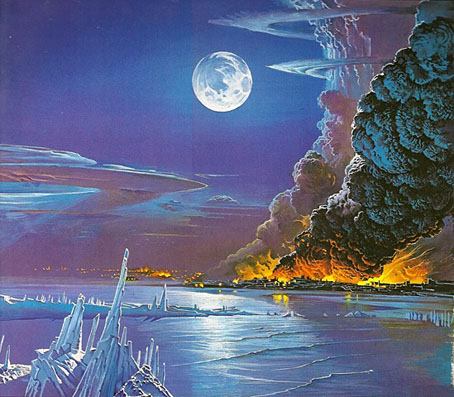
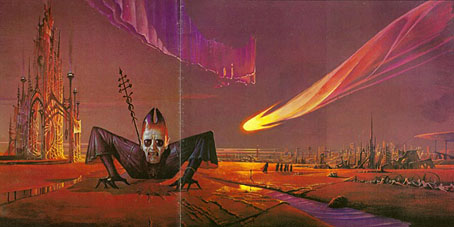
Eschatus: back cover. A detail from a painting entitled Ghost Rider.
Elsewhere on { feuilleton }
• The illustrators archive
• The fantastic art archive
• The book covers archive
Previously on { feuilleton }
• The art of Ian Miller

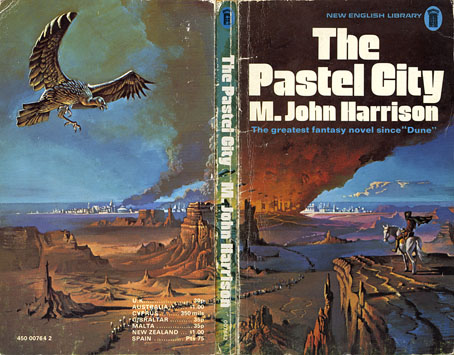
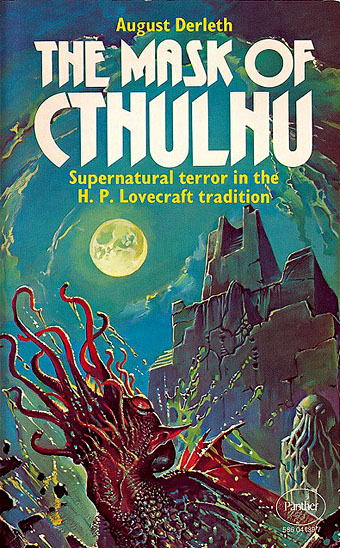
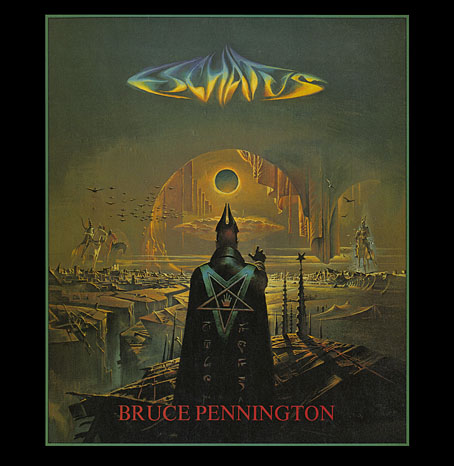
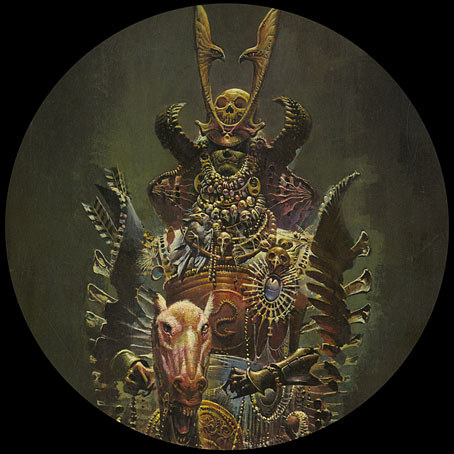
Excellent artist, I’ve a few books on him sitting around that I need to dig up again after seeing this post. That red against blue green Cthulhu cover is amazing. Bruce made one of my all time favorite depictions of Cthulhu on the Tales of Cthulhu Mythos, Volume 1 paperback cover. I shared a high res scan of the painting without text here a few years ago – http://monsterbrains.blogspot.com/2007/01/philippe-druillet-following-pages-are.html
Wow, Aeron I was just on Eaten by Ducks, I go on binges with these random weird blogs. Its interesting that Philippe Druillet is mentioned in the address to that page. I was going to draw a comparison to the style of much of Bruce Pennington’s work to the drawings Druillet did for the books ‘Yaegral Urm’ and ‘La Nuit’. Key differences being Druillet, in those circumstances, was far more baroque in his presentation, while Pennington, though definitely more sparse, was also much more balanced and focused
I’ve been a fan of Bruce Pennington ever since I stumbled on a copy of ESCHATUS years ago while living in Atlanta, Ga. John, I had the same response you did. The prophecies didn’t make any sense whatsoever (they reminded me of Jon Anderson lyrics no less) but I was mesmerized by the visionary art.
You’re right when you say we don’t see too many of his book covers over here in the States but I have managed to aquire all three of the Clark Ashton Smith volumes you posted in your article. My favorite cover is the second volume of LOST WORLDS.
Thanks for the heads up about the FORTEAN TIMES. I’ll look for it.
Aeron: I like the angled architecture on that one but always preferred the flailing squid look of the other cover.
Wiley: One thing Pennington’s Eschatus and Druillet’s Urm share is the image of the Black Sun, one of my obsessive symbols whose appearance I can’t help but notice wherever it occurs. They were probably creating those works at around the same time: Urm was 1975, La Nuit 1976.
Stephen: I got the Fortean Times issue, it’s an interview running over two pages. One interesting detail is his mentioning being influenced by HR Giger after seeing his paintings, presumably when Giger’s Necronomicon was published by Big O in 1977. That may explain the biomorphic landscapes which start to appear in his later work although they still seem very original to me, more organic than Giger’s mechanistic structures.
Thanks for the link!
I see your Pastel City is more knocked about than mine, but the spine is not as faded. I’m pretty sure the cover art was reproduced in the huge Science Fiction Monthly magazine.
Hi John. I keep that copy mainly for the cover as I have a signed first edition of the Doubleday hardback. Didn’t necessarily want a signed copy, that was the only one on offer!
Pennington was a continual feature in SF Monthly as I recall, not surprising since he was doing so many covers for NEL. The publishers compiled a book from the mags called Visions of the Future which I still have, a collection of interviews with many of the artists they were using (some of them not very good) followed by examples of their work.
More about SF Monthly here.